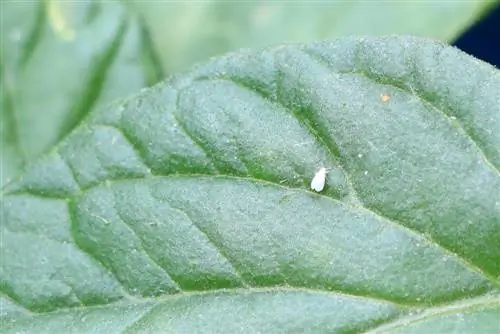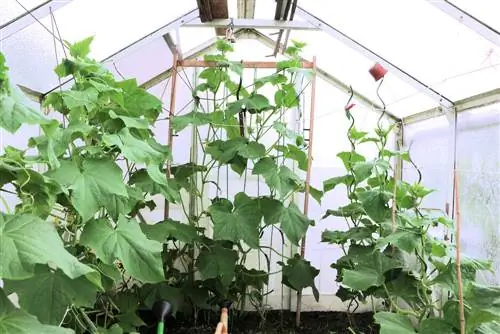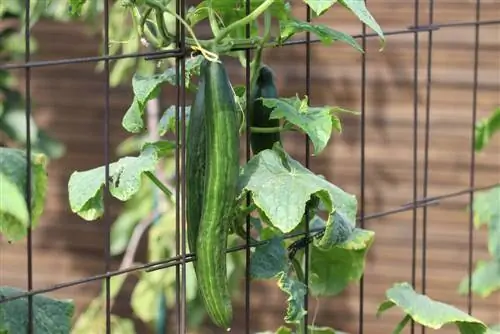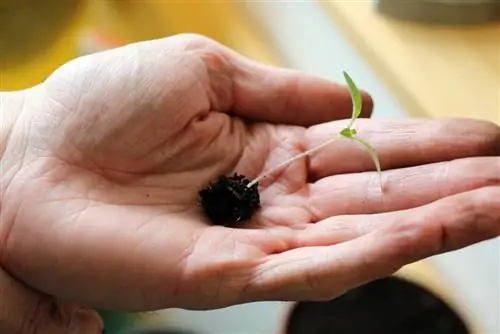- Author admin [email protected].
- Public 2023-12-17 03:39.
- Last modified 2025-06-01 06:48.
If a whitefly infestation is found in the greenhouse, action must be taken quickly. In contrast to them, the relative of the lice has wings and can quickly settle on all plants. It is a pest that sucks the leaves of plants and should therefore be combated as soon as an infestation is first detected. Since it is originally native to the tropical regions of the world, it feels particularly comfortable in warm, moist greenhouses.
Detect infestation
Whiteflies like the vegetables and tropical plants in the greenhouse. Because right here it is humid and warm, just the way they like it. Temperatures around 20° Celsius and high humidity of around 70% are optimal for settlement and propagation. They feel really comfortable in such an environment. It is therefore important to examine the plants in a greenhouse regularly in order to detect an infestation as quickly as possible. With a size of 2 to 3 millimeters, the pest is usually not immediately recognizable at first glance. If the hobby gardener discovers even one whitefly on a leaf, it is usually the case that the infestation is much more advanced and other pests are already in the area. Since the whitefly can lay up to 500 eggs, reproduction is also very fast. Whitefly infestation can be recognized as follows:
- look under the leaves
- likes to sit on the underside of cabbage leaves
- affected leaves can be recognized by a yellow mottling
- the insects suck the plant sap
- the leaves fall off after a while
- when there is a disturbance, pests fly up in droves
- the insects also secrete honeydew
- this can be recognized by the sticky spots on leaves
- This can cause sooty mold fungi to form on the plant
- Tomato plants and other fruits are also often attacked
- also occur on cucumber plants
Tip:
If an infestation has been detected, the entire plant is not immediately affected. It does lose the affected leaves, but since the whitefly does not attack the trunk or stem of a plant, it can continue to grow unhindered. Once the infestation has been combated, new leaves can be formed again.
Prevention
Prevention is particularly important in closed spaces, because pests have the opportunity to spread quickly between the plants once they get inside. Therefore, the greenhouse should always be well ventilated and the temperature should not be too hot. If the greenhouse is in the blazing sun in summer, it should be shaded from the outside. Excessive humidity also promotes an infestation. Other measures can be taken preventatively to ensure that infestation in the greenhouse can be ruled out:
- Check new plants for infestation beforehand
- Whitefly also attacks many ornamental plants
- check these before putting them in the greenhouse
- In order to be able to determine an initial infestation, hang up yellow signs
- the pests stick to this
- so it can be recognized immediately when an infestation is in its early stages
Parasitic wasps
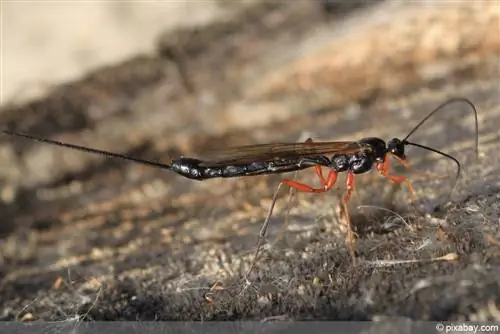
Parasitic wasps are a natural enemy of whiteflies. These are sold in packages to combat pests. A single female parasitic wasp can destroy up to 300 insects. However, the parasitic wasps can only be used from March to September. They are usually available in cardboard cards containing around 500 dolls and are hung in exactly this form in the infested greenhouse. It makes sense to attach several of these cards to the affected plants. When combating parasitic wasps, the following should be taken into account:
- The cardboard cards can be stored in the refrigerator at 8° to 12° Celsius for about 2 days
- in the greenhouse they need warm conditions to hatch
- ideal is 18° to 27° Celsius
- the humidity should be around 70%
- in these conditions the wasps hatch after two to four weeks
- if they no longer find food, they die
- This means that if the whitefly infestation is destroyed, the parasitic wasps will no longer survive either
- natural control doesn't work so quickly
- It can take a few weeks until the infestation is destroyed
Tip:
However, combating parasitic wasps only makes sense if the plants have not been treated chemically at least six weeks before use. Otherwise, this natural enemy could harm the whitefly and its use would have no effect.
Isolating plants
If a whitefly infestation has been recently discovered in the greenhouse and only one or two plants have been infected so far, then it is helpful to isolate the infected plants from the others and change the location as quickly as possible. This is of course easier if the plants were grown in containers in the greenhouse. However, digging up an adult plant makes less sense. If the infected plant has been isolated, proceed as follows:
- - find a new location
- - far away from other plants
- - keep it cool and airy for some time
- - Keep humidity low
- - Ideally the place is drafty or windy
- - the insects don’t like that at all
- - unfortunately such a location is not good for many plants
- - so keep a close eye on it
- - as soon as the whitefly has disappeared, return it to its old location
Yellow sticker
Yellow stickers are also available from well-stocked garden shops and are not a chemical agent. These are small yellow stickers or larger boards that have an adhesive layer. These can be used not only when an infestation is detected, but also as a preventive measure. The adult whitefly is attracted to the color yellow, flies to the stickers and sticks to them.
Natural remedies
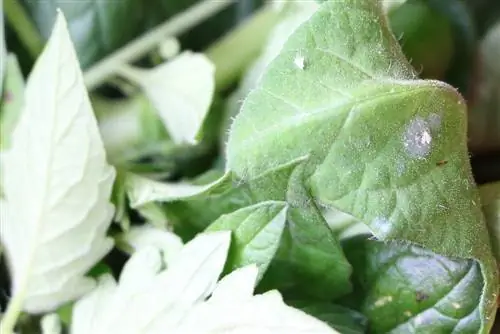
At the same time as using the yellow stickers, whitefly infestations can also be combated using natural household remedies. This is how you can combat the pests with various home-made solutions:
- a solution of water and rapeseed oil suffocates the pests
- A soft soap solution has also proven very effective
- the whitefly doesn't like basil
- Let the herb steep in water and spray the affected plant
- this also works with nettles
- Larvae, on the other hand, are destroyed by a shower of cold water
Tip:
The chemical solution should really always remain the last solution if the whitefly cannot be controlled with anything else. Especially in a greenhouse with crops such as various vegetables, tomatoes or cucumbers, it is not entirely harmless to your own he alth if insecticides are used.
Conclusion
It is not always necessary to use the chemical club directly when the whitefly has settled in the greenhouse. When setting up the greenhouse, advance measures can be taken, such as attaching yellow boards or yellow stickers in the various corners. If individual plants have been infected, they can be isolated immediately so that the whitefly does not spread. If this does happen, the natural predators, parasitic wasps, can help to get the infestation under control. However, good ventilation of the greenhouse can always prevent an infestation.


